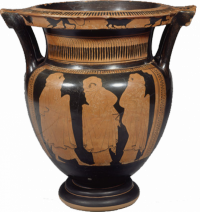Standing woman wearing chiton and mantle
Learn more about the object below
Greek women could not go outside unaccompanied, and when they were in public, covered themselves from head to toe. This woman wears a chiton, a traditional Greek garment, and cloaks her arms and head in a mantle, concealing nearly her whole body in thick folds of fabric. Such attire was a symbol of modesty, though historians speculate that some women may have dressed in this fashion in preparation for a mantle dance; they would cover their bodies in clothing and dance in honor of a god. No records of this mantle dance exist except for representations in art, such as Mount Holyoke’s column krater depicting veiled dancing women.
Label text by Sylvia Peterson (MHC '12)
Suggested Readings:
"Chiton (clothing)--Britannica Online Encyclopedia." Encyclopedia-Britannica Online Encyclopedia. <http://www.britannica.com/EBchecked/topic/113345/chiton>
Caroline M. Galt, “Veiled Ladies.” American Journal of Archaeology, Vol. 35, No. 4 (Oct. - Dec., 1931), pp. 373-393.



